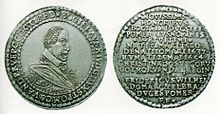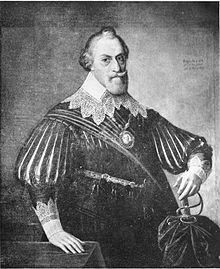Bogislaw XIV (Pomerania)
Bogislav XIV. , Also Bogislav XIV. Or Bogislaus XIV. , (Born March 31, 1580 in Barth , † March 10, 1637 in Stettin ) was Duke of Pomerania-Stettin and belonged to the family of the Griffin . From 1622 he was also titular bishop of Cammin and from 1625 the last duke of all of Pomerania.
Life
Bogislaw XIV was the son of Duke Bogislaw XIII. from Pomerania and his first wife Klara von Braunschweig-Lüneburg .
Together with his brother Georg II , he took over the administration of the offices of Rügenwalde and Bütow from 1606 , after his death in 1617 alone.
In 1615 he married Elisabeth von Schleswig-Holstein-Sonderburg (1580–1653). This marriage remained childless.
The Thirty Years War raged from 1618 , from which Pomerania was initially spared. Bogislaw acted neutrally at first, but could not withstand the pressure from outside successfully. In 1626, the establishment of its own state defense with the deployment of the estates and recruited soldiers did not get beyond the beginnings.
The Swedish-Polish War hit the Pomeranian Duchy only indirectly. His relative, Duke Friedrich von Kurland, temporarily allied himself with the Swedes in 1621, despite the feudal sovereignty of Poland. Bogislaw XIV had to stand up for him with the Polish king and took his brother Wilhelm into his home.
With the death of his brothers Franz (1620) and Ulrich (1622) he became the ruling Duke of Pomerania-Stettin and Bishop of Cammin. After the childless death of his cousin Philipp Julius , who had ruled the partial duchy of Pomerania-Wolgast , he took over rule there in 1625. But the united duchies retained their independent administration. As before, the former parts of the country were administered separately from Stettin and Wolgast .
Despite the emperor's assurance not to occupy Pomerania, Wallenstein invaded Holstein, Brandenburg and Mecklenburg in the summer of 1627 and shortly afterwards also Pomerania. Due to the so-called Franzburg surrender in autumn 1627, Bogislaw had to agree to the billeting of imperial troops. Only Stralsund refused to take on occupation troops and successfully withstood the siege by Wallenstein with Danish and Swedish help. An alliance agreement between Sweden and Stralsund, which was concluded in 1628, actually meant the city's political independence and the loss of all control by the duke as sovereign.
In the meantime, the billeted imperial troops were reinforced several times and developed into a real nuisance. Bogislaw therefore made several representations to the emperor and later used this behavior of the occupying troops to defend his alliance policy with Sweden.
After his successful landing in Pomerania, Gustav II Adolf of Sweden forced Bogislaw XIV to form an alliance at the Szczecin Palace in August 1630 . The contract that was finally negotiated on August 25, which was dated back to July 10 for political reasons, was called a defensive alliance. The Duke was able to keep the civil administration, but the country was occupied by Swedish troops. Paragraph 14, however, threatened the Brandenburg claims to the succession in Pomerania, since Sweden did not need to vacate the duchy until all of its satisfaction claims had been satisfied. Bogislaw XIV continued to strive for neutrality towards Gustav II Adolf and the imperial troops under Field Marshal von Arnim , which were driven out of the country by the Swedes by the summer of 1631 after the conquest of Kolberg and Greifswald.

In 1632, Duke Bogislaw XIV, since he was childless, reassured the Elector of Brandenburg the right of succession that had existed since the Treaty of Pyritz in 1493. In the spring of 1633 he suffered a stroke and from then on was in fact unable to act. As his successor as Bishop of Cammin, he succeeded in nominating his nephew, Ernst Bogislaw von Croy , as a preferred candidate.
Bogislaw XIV died on March 10, 1637 (old style). Until 1638, a secret council based on the regimental constitution of 1634 ran the business of government. A violent dispute broke out between Sweden and Brandenburg over the successor. It was not until 1647 that an agreement was reached in principle on the division of the duchy including the Cammin monastery.
After the Peace of Westphalia in 1648, the Duchy of Pomerania was divided between Sweden ( Swedish-Pomerania , today Western Pomerania ) and Brandenburg ( Western Pomerania ). It was not until the Szczecin border recession of 1653 that the last details of the demarcation between Sweden and Brandenburg were clarified. Only then, in 1654, were both sides ready to bury the corpse, which had been laid out up until then, in the ducal crypt in the Szczecin Castle Church in a joint ceremony.
literature
- Gottfried von Bülow : Bogislav XIV . In: Allgemeine Deutsche Biographie (ADB). Volume 3, Duncker & Humblot, Leipzig 1876, pp. 56-58.
- Roderich Schmidt : Bogislaw XIV. In: New German Biography (NDB). Volume 2, Duncker & Humblot, Berlin 1955, ISBN 3-428-00183-4 , p. 418 f. ( Digitized version ).
- Martin Wehrmann : Genealogy of the Pomeranian ducal house. Leon Sauniers Buchhandlung Verlag, Stettin 1937, p. 127.
Web links
- Publications by and about Bogislaw XIV. In VD 17 .
- Literature about Bogislaw XIV. (Pomerania) in the state bibliography MV
| personal data | |
|---|---|
| SURNAME | Bogislaw XIV. |
| ALTERNATIVE NAMES | Bogislav XIV .; Bogislavs XIV. |
| BRIEF DESCRIPTION | Duke of Pomerania |
| DATE OF BIRTH | March 31, 1580 |
| PLACE OF BIRTH | Barth |
| DATE OF DEATH | March 10, 1637 |
| Place of death | Szczecin |



